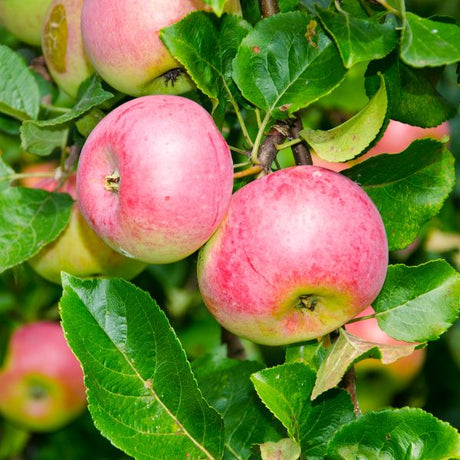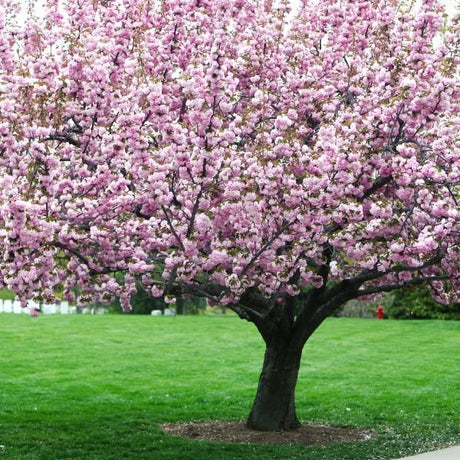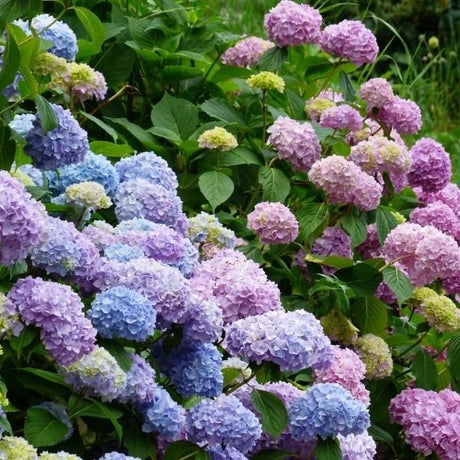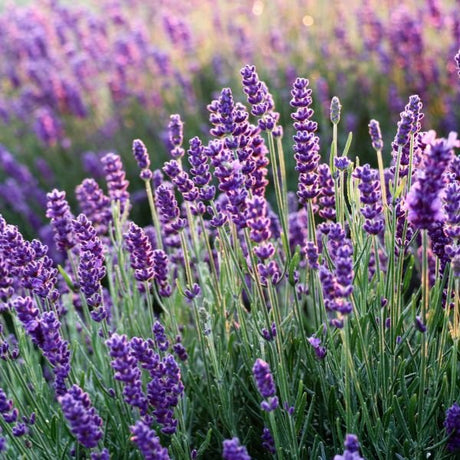Winesap Apple Tree
- Stay Protected with Plant Sentry ™
Winesap Apple Tree - 3-4 Feet Bareroot is backordered and will ship as soon as it is back in stock.
To receive an email notification when our next crop is ready, please enter your email below..*
Plant Sentry™
Plant Sentry™
Plant Sentry is designed to protect both consumers and the nursery trade from invasive plant pests and diseases. Sites that display the Plant Sentry protection badge are protected from consumers buying and nurseries shipping material carrying invasive pests and diseases.
This proprietary eCommerce software prevents the shipment of a restricted plant to each state. The Plant Sentry system includes a shipment certification program. The Plant Sentry Compliance Officer works closely with NatureHills.com and each nursery or fulfillment center to ensure only compliant plants are sold to customers.
Click Here to learn more

Delivery and Shipping
Delivery and Shipping
Shipping
To obtain a more accurate shipment time-frame, simply enter your zip code in the “Find Your Growing Zone” box to the right. Our plants are grown all over the country and lead time on items may be different because of this. Once your order is placed, you will also receive the specific shipment time-frame information as part of your order confirmation. Once an item ships, you will receive shipment notification and tracking numbers, so you can follow along while your plant travels to your doorstep. We use FedEx, UPS, or USPS at our discretion.
Due to winter weather we have put a hold on shipping to the areas shown below in grey. You can still order now and we will ship the plant to you during an appropriate time for your zone.
Standard Shipping Rates
At Nature Hills we handle, package and ship the products you order with the utmost care to ensure healthy delivery. Shipping and handling charges are calculated based on the tables below. Please note that some items include an additional handling surcharge, these will be noted on the item's product page.
| From | To | S&H |
|---|---|---|
| $0 | $19.99 | $24.99 |
| $20 | $49.99 | $29.99 |
| $50 | $69.99 | $34.99 |
| $70 | $99.99 | $39.99 |
| $100 | $129.99 | $44.99 |
| $130 | $149.99 | $48.99 |
| $150 | $150+ | Approx 28% |
Click here to see our full rates
Buying Options for Plants
Nature Hills sells a large variety of plants with several options available. Plants are offered in both potted containers and as dormant bare root without soil. Here is a helpful resource to understand your options as you create a beautiful landscape with help from Nature Hills.
Ever wonder what a larger plant will mean for your landscape? Container Sizes are really all about the age of the plant!
Seasonally, Nature Hills offers hand selected, high quality bare root trees, shrubs and perennials. Bare root plants are sold by height from the top of the root system to the top of the plant. Plants may be taller than the height minimums.
- Popular sizes of select trees are 1 foot, 2 feet, 3 feet, etc.
- Popular sizes of select bare root plants is 1 foot, 18 inches, etc.
Nature Hills Container Size by Volume
Keep in mind, specific varieties and different growing conditions can affect the rate at which plants grow. Variations in size may occur.
| Young Plants to 18 Months | ||
|---|---|---|
| Size | Volume | |
| 2"x2"x3" | Ranges from | .18 to .21 dry quarts / .198 to .23 dry liters in volume |
| 4.5" Container | Equal to | .65 dry quart / .72 dry liter in volume |
| Sprinter Pot | Equal to | .63 dry quart / .69 dry liter in volume |
| 4" Container | Ranges from | .31 to .87 / .35 to .96 dry liter in volume |
| 6" Container | Equal to | 1.4 dry quarts / 1.59 dry liters in volume |
| 1 Quart | Equal to | 1 dry quart / 1.1 dry liter in volume |
| 5.5" Container | Equal to | 1.89 of a dry quart / 2.08 dry liters in volume |
| 4"x4"x5" | Ranges from | .8 to 1.1 dry quarts / .88 to 1.2 dry liters in volume |
| 4"x4"x6" | Ranges from | 1.0 to 1.3 dry quarts / 1.1 to 1.41 dry liters in volume |
| 4"x4"x9" | Ranges from | 1.1 to 2.1 dry quarts / 1.2 to 2.3 dry liters in volume |
| 4"x4"x10" | Ranges from | 1.7 to 2.3 dry quart / 1.87 to 2.53 dry liters in volume |
| Plants 18 Months - 2.5 Years Old | ||
|---|---|---|
| Size | Volume | |
| 2 Quart | Equal to | 2 dry quarts / 2.2 dry liters in volume |
| #1 Container | Ranges from | 2.26 to 3.73 dry quarts / 2.49 to 4.11 dry liters in volume |
| 5"x5"x12" | Equal to | 3.5 to 4.3 dry quarts / 3.85 to 4.74 dry liters in volume |
| Plants 2 - 4 Years Old | ||
|---|---|---|
| Size | Volume | |
| #2 Container | Ranges from | 1.19 to 1.76 dry gallons / 5.24 to 7.75 dry liters in volume |
| #3 Container | Ranges from | 2.32 to 2.76 dry gallons / 10.22 to 12.16 dry liters in volume |
| Plants 3 - 5 Years Old | ||
|---|---|---|
| Size | Volume | |
| #5 Container | Ranges from | 2.92 to 4.62 dry gallons / 12.86 to 20.35 dry liters in volume |
| #6 Container | Ranges from | 5.25 to 6.01 dry gallons / 23.12 to 26.42 dry liters in volume |
| #7 Container | Ranges from | 5.98 to 6.08 dry gallons / 26.34 to 26.78 dry liters in volume |
Plant Highlights
Winesap Apple Tree highlights at a glance!
Plant Highlights
Plant Highlights
-
Brand
-
Botanical Name
-
Growing Zones
-
Mature Height
-
Mature Spread
-
Sun ExposureFull Sun
-
Moisture
-
Soil
-
Growth RateMedium
-
Fall Color
-
Pollinator Friendly
-
Pollinator Required
-
Pruning Time
-
Bloom PeriodLate Spring
-
Harvest Time
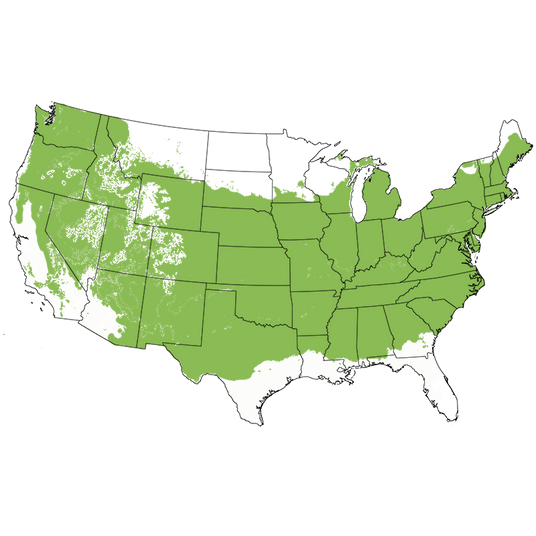
Growing Zones 5-8
Create Your Own Orchard At Home
- Gorgeous Yellow Fruit & Red Blush
- Spritely & Tart & Sweet Taste
- Yellow Flesh With Red Tinges
- Crisp, Firm Juicy Fruit
- Fragrant Pinkish Red Blooms in Spring
- Pollinators Galore!
- September to October Harvest
- Consistent & Heavy Fruit Production
- Also Known As Stayman Winesap
- Eaten Fresh, Juicing, Baking & Drying
- Keeps Well in Storage
- Does Require a Pollinator
- Moderate Disease Resistance & Rust Resistant
- 600-800 Chill Hours
The Winesap Apple Tree (Malus 'Winesap') is an heirloom Apple variety whose history dates from the 1700s. The variety was further developed in the 1800s and became a fast favorite among growers. Still one of the leading varieties being grown in the United States, and if you plant one (or 20), you'll quickly see why!
Nature Hills Nursery’s Winesap Apple is also called the 'Stayman Winesap Apple', and is a prime choice for eating fresh, juicing and baking.
This is no wallflower! In springtime, bright red blooms provide a resplendent show, creating a spectacle the whole neighborhood can enjoy.
When harvest time comes in September or October, your tree will be heavy with large-sized fruit. The flesh is tart yellow and very juicy, tinged with russet and red dots, and occasionally some red veining.
This moderately crisp Apple has a firm, somewhat coarse bite with a spritely, tart, acidic taste, complete with a wine-like flavor. Thought to be one of the juiciest varieties, the Winesap is an all-purpose Apple you can slice for fruit trays and salads, crisps and tarts, or even bake a classic Apple pie.
This delicious apple keeps for up to three months in cold storage, so you have lots of time to preserve your harvest, whether you can them, make Applesauce and Apple butter, or choose to dehydrate them for enjoyment all year long.
How to Use Winesap Apple Tree In The Landscape
The spring display is unlike any other Apple tree with brilliant pinkish-red blooms instead of more typical white and pink. Fragrant blossoms erupt onto the scene and call beneficial pollinators.
Also drawing your neighbors attention, a privacy row of these lovely trees will not be minded by anyone being hidden from the view!
The upright, oval shape is just another ornamental quality this tree provides! Line your property or tuck among your other planting beds to provide shade and tasty snacks throughout the growing season.
Shade your patio or vegetable garden or set your picnic basket beneath one of these beauties for a spring Apple blossom party all your own!
Gorgeous as specimen and accent plants, edible landscaping and dual-purpose sites are perfect for these smaller-sized trees. Home orchards welcome the addition of this fantastic heirloom.
#ProPlantTips For Care
Growers love the easy-to-maintain tree, grown in zones 5-8. Requiring full sun for the largest yield, provide at least 6 hours of direct sunlight a day.
A smaller-sized tree, this variety grows best in dry, sandy, well-drained soil with regular watering. Not drought tolerant, these need supplemental watering and mulch for moisture retention.
Prune to thin fruit, or while dormant to keep the canopy open, allowing sunlight and air circulation into the interior.
Order your red blooms and red fruit of the Winesap Apple tree from NatureHills.com today and get started now before these antique gems sell out!
Winesap Apple Tree Frequently Asked Questions
When to Plant Winesap Apple Trees
Planting Bareroot trees as soon as you can dig a hole in spring and until hot weather, the earlier the better. Plant container Apple trees throughout the growing season with complete success - that is the benefit of container plants - to extend the planting season. Your County Agricultural Extension Office is a great resource for first and last frost dates in your area.
How to Plant Winesap Apple Trees
Dig a large hole only as deep as needed to accommodate the bareroot or container root ball, and twice as wide. Add Nature Hills Root Booster to speed root establishment. Remove the pot or bag and situate it into the hole so the top of the soil (soil line if bareroot), is level with the new location's soil being careful not to plant too deep. Water in again very well and backfill with the same soil you dug up, tamping down gently to ensure there are no air pockets.
Top off with a 3-4 inch thick layer of Arborist mulch. Consider staking your tree to keep its trunk growing straight for the first year to ensure it stands tall against strong winds and drifting snow.
When to Prune Winesap Apple Trees
Trim off any broken branches from delivery as soon as you take them out of the box. Prune and trim apple trees while dormant, in late winter or early spring, before you see new growth.
How to Prune Winesap Apple Trees
Dormant prune to:
- Remove any double leaders or narrow crotch angles
- Eliminate any crossing branches
- Thin interior branching and leave the fruiting spurs and strong branches in place opening up the canopy
- Branching at least 24-36 inches above the ground
Prune Apple trees in the summer to:
- Control size and shape by reducing the length of longer new growth on vigorous trees
- Remove water sprouts on the main trunk or older branches in the crown
- Remove suckers at the base of the trunk
- Thin fruit during heavy years on established trees
How to Care for Winesap Apple Trees
Growing an apple tree is easy when proper soil, good drainage, attention to moisture, and regular fertility are maintained. Once you've chosen an apple tree that works for your climate, in the size you need for your landscape, and its pollinator (if needed), then you've accomplished half the battle!
- Apple trees do best in full sun and well-drained soil
- Water your apple trees when it gets dry - especially during the fruit production stage, and drought periods to keep it stress-free
- Use arborists' wood chips to mulch over the roots of your apples and have your soil tested to see what your soil may be lacking before adding fertilizers
- Maintenance pruning and shaping
Apple trees will tolerate a wide range of soils, so long as water and nutrients are not limited and the pH level is adequate.
How to Fertilize Winesap Apple Trees
For the first year, water alone is most important. It is always best to get a soil test to see what your soil is lacking before adding more fertilizers. Once established, a fertilizer routine may be beneficial. We do offer some excellent slow-release organic options, applied according to the package directions.
Fruit trees need more phosphate and it's possible to apply too much nitrogen which affects the soil's pH. Test soil acidity or alkalinity using a pH Tester.
Fertilize in spring when you first see new growth emerging.
- Don't overdo it
- Phosphates are your friends
- Pay attention to pH in areas with extremely high or low soil pH
- Follow the directions
Winesap Apple Tree Pollinating Info
Winesap is not self-fruiting and needs a pollinating partner. Pair with one of these varieties:
Harvest Times for Winesap Apple Trees
Winesap’s are typically ready to harvest in October.
Early-Season? Mid-Season? Late-Season? The terminology can be confusing for new apple tree growers. Weather, climate and your tree determine when it's ripe.
For Apples:
- Early-season is usually June-July
- Mid-season can be August-September
- Late-season can be from late September-November
The growing season consists of spring, summer, and fall, and varies with climate and weather. Areas with longer growing seasons in the warmer hardiness zones can greatly affect the harvest times for each particular apple variety grown in your area. Learn which growing zone you are in.
What Shipping Options Do You Offer?
NatureHills.com works closely with our growers and nursery professionals to ensure we ship when it is most appropriate for your area. Our goal is to deliver the hardiest plants by avoiding extreme high and low temperatures. Check out our shipping schedule for more information and to learn our wills and won'ts when it comes to shipping plants. Find your Winesap Apple Tree for sale here at NatureHills.com!
Rootstocks Explained
Apple trees have been grafted onto different rootstocks since before the mid-1800s. Different rootstocks are used to improve the anchoring of trees, eliminate diseases, and reduce the natural mature size of the tree itself. While there are many different types of rootstock, they are all labeled as being either Dwarf, Semi-Dwarf, or Standard.
The apple descriptions, including flowering, pollination, and apple characteristics are the same whether the plant is grown on a standard rootstock or some varying dwarfing rootstock. The overall size can vary by climate and soil but the understock used is ultimately what affects the mature size.
There will be some variation in sizes but as a guide, we are suggesting the overall mature size of these apple varieties are:
Semi-Dwarf Apples
- Height: 12-18 feet
- Spread: 10 - 15 feet
Standard Apples
- Height 18 - 25 feet
- Spread: 15 - 18 feet
Remember that all fruit tree sizes can easily be altered if needed by simple pruning as the trees grow and develop.
Very Long Tradition as an Excellent Cider Apple
As apples go, Winesap traces itself back in American history to the early 1800. This was back in the days when apples were consumed more as cider, rather than eating fresh from the tree. The first notations of the Winesap are from the well-known Dr. James Mease in 1804, the man who is also credited with introducing Soy into the United States.
During this time before water sanitation, drinking water was often not healthy and could lead to death. Fermented Apple Cider purified common water-borne diseases and was the preferred beverage to avoid the sicknesses associated with drinking water.
Dr. Mease recommended the Winesap as a fine choice for cider in his 1804 tome, Willich's Domestic Encyclopedia of Philadelphia, saying "WINE-SOP is an autumn fruit, of deep red colour, and sweet, sprightly taste, makes excellent cyder, which is preferred by some to that of Red Streak." A copy of this book was given to Thomas Jefferson.
The variety was also praised for its great storage life up to 6 months, good size, disease resistance and great eating quality. Its popularity grew into the 1800's as one of the finest apples for hard and sweet cider.
With all the wonderful attributes, the Winesap also became a popular variety for cross hybridization. Many popular varieties of the 1800's would come with Winesap as its parent. Most noted were two varieties still popular today: the Arkansas Black and the Stayman-Winesap.
In 1866, Dr J Stayman of Leavenworth, Kansas planted out several of his Winesap Seedlings and sent selections to different nurseries in 1868. One of the selections that was sent to Charles Downing first produced fruit in 1875. It was determined to be a very special selection and Downing promptly named it in honor of Stayman.
The Stayman-Winesap became a popular apple around 1890 and was touted as an all-around superior choice to the parent Winesap in all regards. Stayman-Winesap is highly regarded for its vigorous growth of both root and top. It boasts large and luxuriant foliage and produces a continual fruit crop of excellent size and flavor. Stayman-Winesap continued to be one of the most popular varieties planted from the East Coast into the Midwest until the early 1960's.




